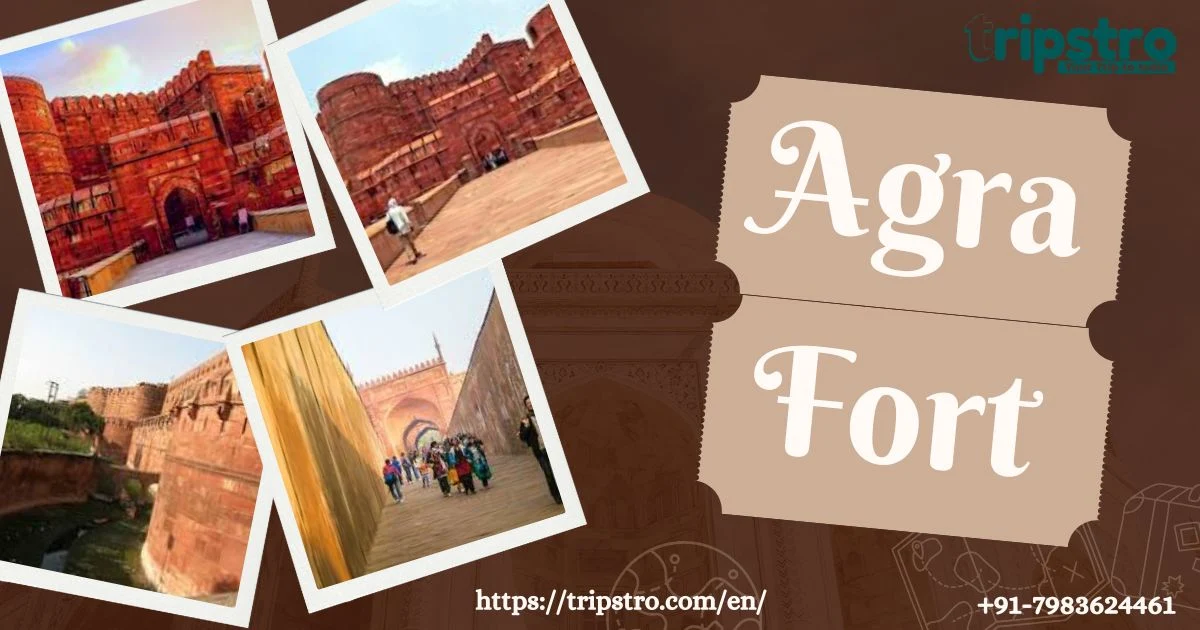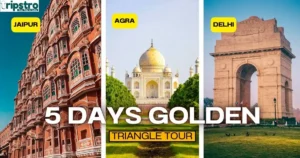There are some monuments in India that don’t just impress you—they leave you speechless. The Agra Fort, also known as Red Fort Agra or Agra Kila, is one such marvel. Rising majestically on the banks of the Yamuna River, this UNESCO World Heritage Site has stood as a silent witness to Mughal grandeur, political intrigue, and the unforgettable love stories that shaped India’s past.
When you enter its colossal Amar Singh Gate, you aren’t just walking into a fort—you’re stepping into the pages of history. Here, emperors made decisions that altered dynasties, queens lived in marble palaces, and Shah Jahan himself spent his last years gazing at the Taj Mahal from his marble balcony. At Tripstro – Your Trip To India, we believe exploring Agra Fort isn’t just about sightseeing—it’s about living history, feeling the whispers of the past, and experiencing Mughal culture at its finest.
History of Agra Fort: From Akbar to Shah Jahan
The history of Agra Fort is as layered as its massive sandstone walls. Commissioned by Emperor Akbar in 1565, the fort originally served as a military stronghold. Over time, it transformed into the grand palace of the Mughal emperors.
- Akbar’s Contribution: He laid the foundation, focusing on strength and defense with thick red sandstone walls.
- Jahangir’s Touch: Jahangir added artistic flourishes, turning sections of the fort into luxurious spaces.
- Shah Jahan’s Elegance: Known as the “architect emperor,” Shah Jahan replaced much of the red sandstone with white marble, giving the fort a delicate, palace-like feel.
Ironically, Shah Jahan—who built the Taj Mahal—was imprisoned here by his own son Aurangzeb. From the Musamman Burj, a marble tower, he spent his last days looking at the Taj Mahal, the eternal tomb of his beloved Mumtaz. This tragic tale makes the fort more than a monument—it’s a living memory of love, power, and betrayal.
Places to Visit Inside Agra Fort
Exploring Agra Kila is like unfolding chapters of a Mughal storybook. Each courtyard, hall, and palace has its own significance:
- Jahangir’s Palace: A fine blend of Mughal and Rajput architecture, built for Akbar’s son.
- Diwan-i-Aam (Hall of Public Audience): Where the emperor addressed petitions from the public.
- Diwan-i-Khas (Hall of Private Audience): Once home to the legendary Peacock Throne and Koh-i-Noor diamond.
- Moti Masjid (Pearl Mosque): A pristine white marble mosque that reflects Shah Jahan’s devotion.
- Musamman Burj: The octagonal marble tower where Shah Jahan was held captive with a view of the Taj Mahal.
Each site within the fort reveals a new dimension of Mughal life—be it politics, religion, or personal tragedy.
Agra Fort Architecture: Power Meets Elegance
The Agra Fort architecture is a remarkable blend of strength and beauty. Covering 94 acres, its walls rise 70 feet high, encircling a royal city within. Unlike the Taj Mahal History in English, which symbolizes love, Agra Fort reflects power and governance.
- Design Style: The fort combines Persian, Timurid, and Indian influences.
- Material: Constructed with red sandstone, later embellished with white marble.
- Layout: A mix of open courtyards, underground chambers, palaces, and mosques.
Its unique mix of military precision and artistic luxury makes Agra Fort one of the finest Mughal creations—less romantic than the Taj Mahal, but equally captivating.
Agra Fort Timings and Entry Fees
Before you plan your visit, it’s important to know the Agra Fort timings and entry fees:
- Timings: Open daily from 6:00 AM – 6:00 PM
- Entry Fees:
- Indian Visitors: ₹50
- Foreign Visitors: ₹650
- Children below 15 years: Free
- Indian Visitors: ₹50
Tip: Arrive early morning or late afternoon. The golden sunlight enhances the sandstone walls, making your photos stunning.
Nearby, don’t miss the Tomb of Itmad-ud-Daulah, also called the “Baby Taj,” and the world-famous Taj Mahal. Many travelers combine these sites with a 5-Day Golden Triangle Tour, covering Delhi, Agra, and Jaipur for a complete cultural experience.
Best Time to Visit Agra Fort
Agra’s weather can be extreme, so timing matters. The best time to visit Agra Fort is between October and March, when the weather is cooler and pleasant.
- Summer (April–June): Too hot for long explorations.
- Monsoon (July–September): Green but humid, with unpredictable rains.
- Winter (October–March): Perfect weather with misty mornings and crisp evenings—ideal for photography.
If you’re planning to visit both Agra Fort and the Taj Mahal, winters give the most magical experience with clear skies and soft light.
How to Reach Agra Fort
Agra is well-connected, making the fort easily accessible:
- By Air: Agra Airport is 12 km away. Delhi’s international airport (220 km) is another option.
- By Train: Agra Cantt railway station is the nearest, just 10 minutes from the fort.
- By Road: Well-connected via the Yamuna Expressway and National Highway 19.
Once in Agra, you can take autos, cabs, or cycle rickshaws to the fort. Booking with Tripstro – Your Trip To India makes it even easier—they handle transport, tickets, and guided tours seamlessly.
Comparison: Agra Fort vs Red Fort Delhi
Many travelers confuse Red Fort Agra with Red Fort Delhi. Here’s a quick comparison:
| Feature | Agra Fort (Agra Kila) | Red Fort (Delhi) |
| Built By | Emperor Akbar (1565) | Emperor Shah Jahan (1638) |
| Purpose | Mughal residence & military stronghold | Mughal capital after 1638 |
| Material | Red sandstone + marble | Red sandstone |
| UNESCO Heritage | Yes | Yes |
| Unique Feature | Shah Jahan’s prison with Taj Mahal view | Independence Day flag hoisting |
Both forts are iconic, but Agra Fort is older and historically richer, while Red Fort Delhi represents the later phase of Mughal rule.
Conclusion
The Agra Fort is not just a historical site—it’s an emotion, a memory carved in stone. From Akbar’s vision to Shah Jahan’s tragedy, the fort mirrors centuries of Mughal power and culture. Whether you call it Agra Kila or Red Fort Agra, it deserves a place on every traveler’s bucket list. Nearby attractions like the Tomb of Itmad-ud-Daulah, the Taj Mahal, and cultural journeys like the 5-Day Golden Triangle Tour make your trip even more rewarding. For a seamless, insightful, and enriching travel experience, trust Tripstro – Your Trip To India to craft your perfect Agra journey.
FAQs
1. Are Agra Fort and Red Fort the same?
No. Agra Fort is in Agra, while the Red Fort is in Delhi. Both are Mughal forts but serve different historical purposes.
2. What is special about Agra Fort?
Its blend of military strength and royal palaces, along with Shah Jahan’s tragic story, makes it unique.
3. How long does it take to explore Agra Fort?
On average, 2–3 hours are enough to explore the main attractions.
4. Can you see the Taj Mahal from Agra Fort?
Yes, from Musamman Burj you get a stunning view of the Taj Mahal.
5. What are the nearby attractions to Agra Fort?
Taj Mahal, Tomb of Itmad-ud-Daulah, Mehtab Bagh, and Akbar’s Tomb in Sikandra.





 //
//
